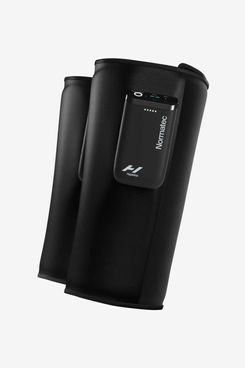
The Strategist happens to be full of runners, so this week, we hit the ground running (literally), testing tons of running gear and interviewing experts to give every kind of runner all the intel they might need. Welcome to Running Week.
In 2023, I hit a wall of back-to-back injuries: a calf strain in the spring, a bruised rib (from a non-running-related bike crash) also in the spring, and, finally, the crème de la crème of injuries: osteitis pubis and a pelvic stress fracture in the fall, causing me to drop out of the Chicago marathon the week of the race and stop running for three months. Luckily, these weren’t my first running injuries, so while it was excruciating to be benched for a season, I had the number of a good physical therapist and an at-home recovery booster.
Two years before, I injured my calf while training for the New York City marathon. My physical therapist’s office, Finish Line Physical Therapy, offered the use of Normatec 3 Legs compression boots as a complimentary post-session perk. I hadn’t heard of or tried any sort of compression boots prior to starting physical therapy and was thankful for the chance to relax after an hour of strength-training exercises. I soon began to look forward to my physical-therapy appointments, craving the tension relief that only these boots seemed to give me (my colleague Jeremy Rellosa wrote more about six months of testing the boots here). When my calf eventually healed and I stopped going to physical therapy for the time being, I longed for the comfort of those goofy space-age compression boots. But they were far too expensive and far too large for my small Brooklyn apartment.
Then, like magic, Hyperice reached out to me about their more portable, bootless version of the boot: the Normatec Go. I called some in to test and have been using them ever since. These sleeves are designed to fit over only the calves and, as such, they have half the bulk of the boots. However, they still offer the heft of the bigger model. There are seven levels of compression intensity that cycle through three different compression zones for a period of either 15, 30, 45, or 60 minutes. While they’re not physically connected to each other, the sleeves work in tandem: Once you adjust the intensity on one side, it automatically adjusts the other calf to that setting as well through Bluetooth.
The magic of the Go boots lies in how you’re able to target your calves. I have what seems like forever tight calves — see: my many, many injuries — and when I’m short on time and just want some post-run relief, these are the perfect thing to wear as I sit at my desk or relax with my breakfast. (I’m even wearing them now.) In just 15 mins, or up to 60 mins, if I have the time, they squeeze out my sore, tight calves in one big tight hug. I usually like to use them after a long running session (for me, that’s ten miles or more when marathon training) to prevent soreness the next day, but they provide quick relief after any length of run. And because they are compact, they are also great for travel. I’ve taken them on road trips to Georgia, New Hampshire, Nantucket, and New Jersey, and I brought them on the plane to California. I look forward to sticking them in my carry-on when I travel for the Chicago Marathon this fall (and to using them in my hotel after the race).
The Strategist is designed to surface the most useful, expert recommendations for things to buy across the vast e-commerce landscape. Some of our latest conquests include the best acne treatments, rolling luggage, pillows for side sleepers, natural anxiety remedies, and bath towels. We update links when possible, but note that deals can expire and all prices are subject to change.






